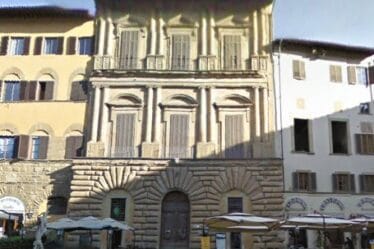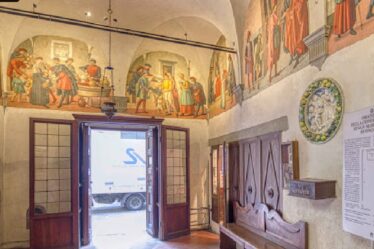

Florence’s Palazzo Pandolfini stands as a prominent piece of Renaissance architecture, notable for its history tied to religious institutions and famous figures of the time.
Early Beginnings: A Rural Outpost for Religious Institutions
The site of Palazzo Pandolfini was initially part of Florence’s outskirts, a region designated for agricultural use, hospitals, and religious institutions. One of the early structures here was the Monastery of San Silvestro, inhabited by Benedictine nuns known as “Le Santucce.” In 1443, the monastery faced a decline, with only one remaining nun, leading its assets to be absorbed by the nearby Monastery of Sant’Agata.
Transition to Secular Ownership and the Arrival of Giannozzo Pandolfini
Afterward, the property was transferred to the Brotherhood of the Archangel Raphael and, in 1447, to the friars of Montesenario. On January 24, 1494, the friars rented a section of the building, described as a “house with garden,” to Giannozzo Pandolfini, Bishop of Troia and a native Florentine. He intended to construct a new residence, documented by the notary Ottaviano da Romena. However, due to financial difficulties, Giannozzo was unable to proceed as initially planned, even falling behind on an obligation to repair the roof of the nearby Church of San Silvestro by 1504.
Renaissance Revival: The Influence of Pope Leo X and the Artistic Touch of Raphael
By February 18, 1516, construction efforts were nearing completion, but an additional boost came from Giannozzo’s connections. In late 1515, during a visit to Florence, Pope Leo X—a Medici pope and friend of Pandolfini—allegedly toured the building, mentioning his visit in a letter from 1520. This relationship allowed Pandolfini to engage Raphael Sanzio, one of the most revered artists of the time, to design his Florentine residence, according to the chronicler Giorgio Vasari.
The Architectural Legacy of Raphael and Giovanfrancesco da Sangallo
Although Raphael’s name was attached to the project, the actual work was carried out by his assistant, Giovanfrancesco da Sangallo, following a Roman-inspired design. This style, while respected, was somewhat unique for Florence and didn’t immediately find popularity. Eventually, Giannozzo’s nephew, Ferdinando Pandolfini, completed the palace, adding a long frieze to the cornice, honoring not only his uncle but also the Medici popes, Leo X and Clement VII, both close friends of Giannozzo.
The Historic Inscription of Palazzo Pandolfini
One of Palazzo Pandolfini’s most distinctive features is its grand Latin inscription running along the building’s cornice:
“Iannoctius Pandolfinius, Eps. Troianus / Leonis X et Clementis VII Pont. Max. Beneficiis Auctus / A Fundamentis Erexit An. Sal. M.D.XX”
Translated, this commemorates Giannozzo Pandolfini, Bishop of Troia, acknowledging the support of Popes Leo X and Clement VII and marking the building’s foundation in 1520.



